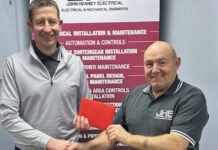
ENERGY trapped within bridges is to be harvested and reused in a major new international project led by Heriot-Watt University.
Traffic and wind regularly causes low frequency vibrations to pass through bridge building materials such as steel and concrete. The university said that, alongside academics at Georgia State University and Georgia Tech, they have recognised an opportunity to capture and recycle the ‘untapped source’ by using the principles of physics.
A device dubbed the vibrant pack energy harvester, created by Dr Danill Yurchenko of Heriot-Watt University, will be used. The autonomous device, measuring around 5-10cm in length, does not require wiring to an electrical power source and is ‘relatively’ cheap to manufacture.
It houses a small ball within a tube which rolls back and forth as the device absorbs low frequency vibrations. As the ball moves it impacts on non-conductive materials known as dielectric membranes located at either side of the tube. Once stretched, a ‘brief’ electrical charge is applied but once returned to its undeformed state the generated excessive electrical charge can be harvested.
The subsequent electrical energy is stored in a battery and used to power a sensor which the university said is capable of monitoring the structural integrity of a bridge. Engineers will be able to record multiple measurements – such as vibrations, traffic load, wind and temperature, all simultaneously without the need for specialist infrastructure to be installed.
The work is being backed by £340,000 in funding from the Engineering and Physical Sciences Research Council, as well £324,349 from the National Science Foundation (NSF) to research and develop a revolutionary vibro-impact energy harvesting device.
Dr Yurchenko, of the school of engineering and physical sciences at Heriot-Watt University, commented, “What we are doing is creating a more efficient and cost-effective solution by harvesting energy that would otherwise be lost. “It’s something that has never been done before in this way.
“It’s a technology that can be used on any bridge anywhere in the world. There are plenty of places where these devices can be fitted to a bridge structure such as on cables, on the pillars, other side of the bridge deck, there really aren’t any limits.
“The biggest problem in energy harvesting is that the absolute amount of energy produced by a typical device is very small due to the low available level of vibrations. In fact, for the past 100 years scientists have been fighting adverse vibrations to ensure that bridges are safe. So, through this work we will try to optimise the performance of our vibro impact energy harvesting device tuning it to the bridge application.”











